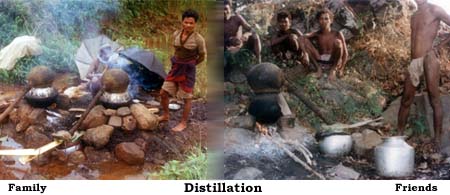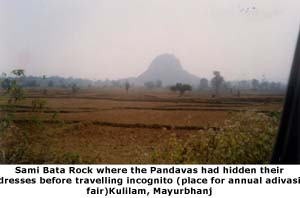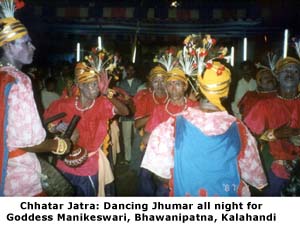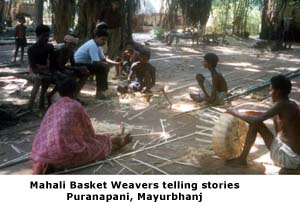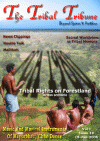Sacred Worldview in Tribal Memory
|
Let’s imagine a tribal habitation where there was no road. No jeep or truck was reaching there. No forest contractors, forest officers were in the forest. People had the worldview that the forest is as eternal as the earth and the universe. Huge forest resource was lying in the forest with out any body’s greed. There was no dearth of natural resources for daily sustenance. People were believing in" to day is to day," not "tomorrow is tomorrow". There was no authority over jungle except the forest goddess and hill gods. All the jungles have female goddesses and the hills and mountains, as male gods.
No cart was even seen in Kalahandi jungle before 1830.The liquor vendors attracted towards mahua tree came to Orissa from Ganjam, and Kalars from Chhatishgarh to Nuapada. Hand made liquor was not plenty- it was like medicine. But manufacture of liquor other than by the tribal people gave a new economic disorder- that is give me your labour, I will give you liquor! Then it turned in to the proverb, Give me your mahul tree, I will give you liquor and money. Then third one is give me your land, I will give you money. With that money you can live happily with liquor. Thousands of tribal people gave their land either to keep the word of truth, or the written paper in which they have given their thumb impression. They are afraid, how dangerous and powerful the writing is, which can turn your life upside down.
Nature and indigenous people are inseparable. Nature has given them a worldview, which is naturalistic worldview. Both the nature and animals are the spit/ or the left over food of the Earth mother Goddess. She is the mother and tree and man, animals are her sons and daughters dependent to each other. Earth mother goddess takes care of her creation by providing all facilities that is available in the earth, air, water, and forest. The supernatural is present both in animate and inanimate. The indigenous people acquired their knowledge from their close association and interdependence with nature. Their experiential knowledge has given them the skill of adapting themselves with the natural environment. The earth, and the forest, the river and the hills, the birds and animals constitute the life of the tribal people and depending on them they construct their knowledge, personality and create folklore. With the changing of time the tribals have also fallen a prey to the change. They do not plan this change. Others "Diku" changed them. This change is just like a new road made to the forest and a jeep or a truck appeared. They appeared to exploit and not to understand the naturalistic worldview. When they destroyed the forest, they did not know that they are cutting the tree in which the goddess is sleeping. They did not care that the hill they blast was the legendary seat of Lord Rama or Sita. They also did not know that the forest, and the land have a social history, attached to the race memory, glory, and creativity of the community. Before people begin to understand that they are being exploited, they were exploited. They lost their land, trees, displaced, rehabilitated, and lost their identity.
Then they were adjusted to the truck drivers, contractors, foresters and guards, revenue officers, and many more development planners. Some could understand their values and worldviews, but could not do any thing. Some did not understand them and followed the orders and finished their targets. Tribal people became the instrument in changing disorder. Truck Driver is more powerful than the contractor. He has the ability to run such a huge truck. Males were exploited in wage labour, but both nature and women were exploited physically. Forest lost its chastity. Greed replaced the need. Till the forest was abundant, there was no threat for survival, so there was no plan for tomorrow. There is blame to the tribal people that, if a tribal has earned for today he will not think for tomorrow. But, in the reverse, his planning of living his life is more flexible than the people who make five years or ten years plan. His attitude to nature has given him how to plan for a day or a season, and not for future. Individual plan is closely associated with community plan. It is inbuilt with nature and environment. Most insecure people plan for future. But man of nature plan with nature. People in need never hoard, but people in greed plan for grabbing. The difference can be compared to the two worldviews. Tribal people living in the village and forest can’t understand the politics of using natural resources. Tribal worldview, unfortunately, has given space to the people who want to exploit them with out understanding their life and culture.
My concern here is to focus on some examples and events, which signifies the symbiotic relation of tribal people with natural resources. As a folklore fellow, I would like to present some items of oral tradition, rituals, and that represents the integrated worldview of the tribal people in relation to the nature and its resources. It is the folklore of the people, which represents the collective knowledge, and experience of the people in their socio-cultural context. Religion and religious practices is ingrained in their physical world, mental texts and supernatural world. The myths, legends, tales, oral epics, caste genealogies, proverbs, riddles, rites and rituals represent the sacred worldview of the tribal people. Each item of folklore, may it be verbal or non-verbal, have purpose and meaning in its socio-cultural context. The function of traditional knowledge in sustenance is highly structured, repetitive and communal. Everybody share the knowledge and practice it in their life, which is inbuilt in their subsistence. Use of space in the mental text of tribal people can be visualized in following order:
Jungle is sacred, and it purifies the sin. In Bhunjia community, when a girl attains her puberty before the Kanabora ritual is instituted, the community consider it a sin and takes the girl to the nearby forest, tie up her in a tree, and her uncle rescue the girl. Then the girl is allowed to come to the village.
The origin myth of tribal community represent for earth, land, water, tree, vegetation, interdependence of man and animal. They learn from the ritual and myth. The tribal priest is responsible for community harmony. The mantras chanted in the worship of Earth mother Goddess is based on an integrated worldview. The meaning of the mantra is Oh Earth mother, It is a festival of vegetation. The philosophical ideas in the mind of the paraja priest can be imagined. The priest says, O mother, In the Dharnikhal- earth pit where the sacrifice is offered, to the earth goddess, a stone is covered to protect it. Comparing the greater earth as a great sacrifice pit and the animals and nature in side the earth covered by the sky like the stone- the jani recites the invocation the meaning of which is for the security of the earth and the universe. We can equally consider the global scientist speaking in global environmental conference; we have only one earth Lets save it. The Jani and the scientist – both pray for saving the world from disaster. One is through his pseudo-scientific belief, and the other is on scientific truth.
The function of myth and ritual is to validate the mind and action of the people for their association of animate with in animate and past with present. Therefore the space used by the tribal people bare vast experience in combining environmental hardship and leading sustainable livelihood. Any word, any action has a purpose and meaning. It is shared, enjoyed, distributed and socialized. Nothing is private in people’s knowledge. The water harvesting techniques, utilisation of forest herbs as source of medicine, metrological assessment, knowledge about the characteristics of birds and animals, knowing the concept of time, using the space as they perceive, are some of the most important aspect which is determined by the experiential knowledge and it is experimented, useful for the people’s welfare with universally agreed values, not imposed, by the community. Oral epics and narratives found among the tribal community of Orissa bear the rich knowledge on their subsistence. The discovery and inventions, shift from one occupation area to the other, water harvesting, leveling the soil, inventing ploughing technology etc. are found described in the oral narratives. Invention of iron and liquor, categories of trees and birds, and animals, kinds of land and forest, association of sacred birds and animals, trees and land as the clan totem, clan based distribution of land and territory etc are vividly narrated in the oral tradition, more particularly in myths and oral epics, and caste genealogies. This reveals the importance of local knowledge perpetuated in their oral performance. In oral epics of Kalahandi it is found that, there is a gradual change from primitive to agrarian society. There is a gradual change from food gathering practice to food producing occupation. Mahadeo is the first cultivator, and inventor of plough. Bhima is the first helper to Mahadeo in cultivation. He is also the inventor of liquor and rainmaker. Bull and buffaloes are the first animals used in the cultivation. Getting rainwater through rituals is another aspect in folklore of Kalahandi. In almost all narratives, water, and land is narrated as most necessary component in tribal life. A Kondh belief about a sacred land for human settlement consists of three symbols. Kondh kurmel matir dub. Jenne basle sethan subh. i.e. a land is considered auspicious, if you see a Kondh has settled there, or the kurmel mouse found there or the grass (dub) is sprouted on that land. It signifies the fertility of land. Selection of a land to dig a pond by the community is based on some experience. Senior people select the land after several testing of soil, and select the land for digging a pond. But the diggers of Mahabandha don’t apply the indigenous knowledge, but dig the pond where the wasteland or government land is available. Relation of land with water is to be explored to know how the natural phenomena regulate the universe of human existence. An African proverb therefore, runs that "those who have uninitiated can not understand us." Similarly, another proverb runs that when an old man in our village dies, a rich library is lost. Both the proverb signifies the importance of local knowledge. Tribal people have never tried to popularize their ideas, or knowledge, except obeying the rules and practices. They have also never discarded the new development order in a new given situation. But there is a gap. The gaps are:
The cultural attitude of tribal people in relation to their land, water, forest, family, society, greater human society and the universe as an integrated whole, therefore, need to be understood. Now, rapid deforestation, new economic order, new development plans in which tribal people serve not as a master, but as a slave, have forced the tribal people to forget their traditional wisdom. With the natural loss, cultural loss also goes hand in hand. Obsession with the past, perception of tribal people, psychologically, may be in a state of mind, unable to cope up with current development mechanism, and thereby a maladjustment. Or it may be possible that the tribal people having been beholden to the primary westernization have abandoned their traditional wisdom. Many tribal people feel that their language is inferior in comparison to the state language or foreign language. Culture of community dance is stopped considering it as social evil. Similarly, oral tradition tales, myths, legends with lots of local history and social history is lost, and loosing its relevance with the introduction of written knowledge. It is seen that being affected by the mainstream culture, many educated tribal people have given up their language, culture and never thought of their traditional wisdom. Now, when we attach importance to the indigenous knowledge and traditional wisdom, they will/ may regenerate their knowledge. In Search of Cultural Action: Natural world takes shape in to a cultural world through human experience, imagination, reasoning and memory, as they feel necessary. Nature is perceived, as the mankind understands it. Tribal world have recreated the cultural world through its collective memory, which is drawn from natural world. Human resource and natural resource have symbiotic relationship. Culture is created in the context of nature. Human being construct belief, knowledge and attitude from the life experience. This helps them creating folklore which is experiential. Folklore as the vehicle of communication and transformation of knowledge plays the role of perpetuating knowledge. It also changes with changing situation.
In order to sustain natural resources, people’s traditional knowledge need to be acknowledged. This can be made operational through:
|
Source : Photographs by Dr. Biyotkesh Tripathy
Distillation Photograph: Dr. Ramesh Prasad Mohanty
Note:
References :


